Fatbike tour along Oregon’s coast
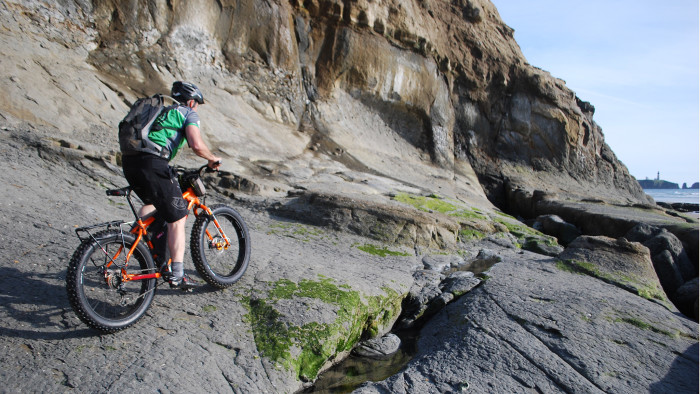
Roula Khalaf, Editor of the FT, selects her favourite stories in this weekly newsletter.
My bike is fat, so fat, in fact, that strangers are staring. They use words such as “enormous” and “huge”. I wave and pedal past their pointing fingers. We have miles to go, me and my fat.
To be clear, the bike isn’t obese (and nor am I). It looks like a fairly normal mountain bike with commanding handlebars, a matt black frame and shiny disc brakes. A decal does read “Fatback”, the name of the manufacturer, but it’s the tyres that really stand out. They’re clownish rings of bloated rubber some 4.25in wide, more than twice the width of a normal mountain bike tyre. Imagine sea lions wrapped around the spokes.
The reason they’re so blubbery is clear. Just as fat skis provide more float in powder snow, fatbikes make cycling across soft, undefinable surfaces possible and even pleasing. Bikers in Finland can now ride trails long before the snow melts. Tireless commuters in the US Midwest pedal them to work in blizzards.
In the right conditions, fatbikes are surprisingly efficient. In March, American cyclist Jeff Oatley rode a Fatback across the finish line of the 1,000-mile-long Iditarod sled-dog race a full two days before the fastest mushers arrived (like all bikers, he’d been given a week’s headstart, but never before had a cyclist beaten the dogs with such a commanding lead). A few months earlier, British adventurer Maria Leijerstam became the first person to ride to the South Pole – a feat achieved on a three-wheeled fat-trike.
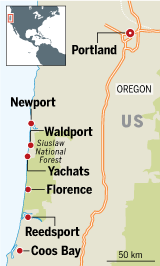
Though the bikes trace their roots to the 1980s, it is only now that they are gaining momentum worldwide. Outdoors magazines and websites are full of stories about epic fatbike expeditions; bike shops show off the latest monsters in their windows; tour operators are working on plans for marketing fatbike trips to tourists. “Fat is definitely becoming a trend,” says Mark Eller, communications director at the International Mountain Bicycling Association.
I have come to the coast of Oregon to test the fatbike’s potential on a four-day trip travelling south from Newport. It’s a state made for cyclists – with just 3.9m people in an area slightly larger than the UK. A mountain biker can cross almost all of it on trails that punch through old-growth forests, climb the volcanic Cascade Mountains and dive into the scratchy hinterlands of the Great Basin desert. But fatbikes are opening new routes too – my exploratory trip will follow the coast, using the beach in place of road or bike path.
…
Almost immediately I can tell this is going to be a fun trip. The Fatback’s wheels, which felt grotesque in the car park with all the pointing strangers, are now tearing across the sand like unchained huskies. Waves rumble in from the Pacific while the green humps of the Coast Mountains rise to my left. I pick up the pace and slice through the remains of a dying wave.
The Oregon coast is littered with state parks thanks to one of its earliest governors, Oswald West, who in 1913 decreed the entire length of the coast “a public highway” that would “forever remain open as such to the public.” He meant it literally: with few roads along the coast, the beaches served as thoroughfares for horses, carts, stagecoaches – and now, 101 years later, fatbikes. Most of the parks allow camping but some have cabins and yurts, which provide ideal accommodation for the travelling biker.
Though sections of the coast are too rocky to ride, my plan is to explore some of the longest stretches of beach for roughly 100 miles from a state park north of Newport to the salty timber town of Coos Bay in the south. I’ll stay in yurts along the way and pop into towns for pints of beer and seafood so fresh “the ocean hasn’t missed it yet”, as locals like to say.
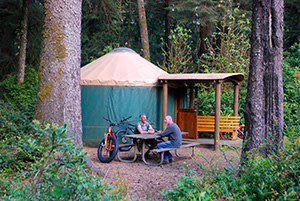
“Man I just love the adventure of this!” hoots my riding companion Joe Kidd, an ebullient 49-year-old police officer from Eugene, Oregon’s second-largest city. In summer, Joe will sometimes spend days riding old stagecoach roads across the Cascades with as much as 90lb of gear strapped to his fatbike. Today, he rides with gleeful energy, spinning in circles, jumping over rocks and charging into waves. He’s so friendly and enthusiastic that it’s hard to believe there’s a loaded gun in his handlebar bag. “You just never know,” he says.
No one really knows how to offer organised fatbike tours on the Oregon coast just yet, either, but Randy Dreiling, owner of a small operator called Oregon Adventures, is working on it. When I told him about my plan, he put me in touch with Joe and agreed to ferry our gear in his van in exchange for providing information about the trip. If all goes well, Dreiling will offer a coastal fatbike tour next summer. For now Joe and I just have Google Earth apps on our phones to guide us, though it seems impossible to get lost: just keep the ocean on your right.
We barely cover 11 miles, from Beverly Beach State Park to Newport, on day one, not because it is hard but because playing among the rocks is such fun. “It’s too pretty to go fast,” says Joe.
…
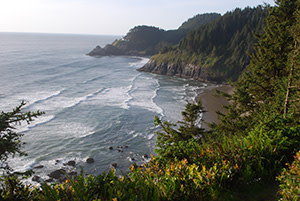
The Pacific keeps the coast cool, even in summer but day two hits 29C with a hammering sun. After meals of fishwives’ stew and pints of locally-brewed Rogue ale, we spend the hottest part of the day crabbing in Newport until the shadows grow long and the temperatures drop. Then Joe and I gear up and head out.
Our plan today is to ride about 20 miles from South Beach State Park to a town called Waldport on the Alsea river, where Dreiling will meet us with a van. We pedal along at a leisurely 8mph as the afternoon teases out every ripple and divot in the sand. I thread my front wheel along the sea foam and chase noisy seagulls.
Eventually we reach Ona Creek, which looks deep and intimidating coursing over the sand. “I’m going for it,” Joe says, and he grinds his way across, despite water slapping his knees. It’s such fun, he turns around and rides it again. Maybe fatbikes work well in water too.
Me? I use the quaint footbridge, its salt-slathered boards arched over the water and the grass. The air smells of red cedars and yews. A woman waits at the end of the bridge with a skittish little dog.
“See the bald eagle in that tree?” she asks. The bird looks huge and has talons that could kill a deer. “Probably thinking of an easy meal,” she says and scoops up her dog.
Oregon also has bears, mountain lions and wolves but the biggest concerns for coastal fatbikers are the wind and tides. We learn this after a couple of nights at Jessie M Honeyman Memorial State Park near Florence, where we stay in small but cosy canvas-walled yurts and enjoy seafood jambalaya and mussels cooked in wine. The park is close to some of the coast’s most spectacular topography – the Oregon Dunes National Recreation Area, a sandscape of 500ft-high dunes. We ride the fatbikes on them but it doesn’t really work in such loose sand.
Instead, we spend most of day three on an 18-mile spin to the Umpqua river along the western edge of the dunes. The wind has switched direction to blow in our faces, and the incoming tide leaves only a narrow lane of firm sand – “I suppose we should have checked the charts,” says Joe.
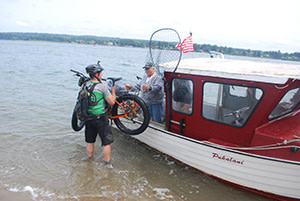
We do our best and ride in convoy more like road bikers, banging out the miles. We pass sandpipers hunting for crustaceans, but mostly we are alone in a silvery light that blurs the line between sand and sky.
Who knows if fatbiking will catch on? The machines can cost as much as a regular mountain bike and there’s little reason to own one unless you live near sand or snow. Yet the appeal is undeniable, because they also blur the line between what’s rideable and what isn’t. For now, sales are booming (see sidebar, left).
The last day of our ride tests that line, and frankly, it is brutal. The headwind grows from a nettlesome twerp to a two-fisted bully and the tide is so high we must plough through loose sand or crashing waves. The 20-mile ride from Ziolkouski Beach down the North Spit towards Coos Bay takes more than three hours and we overshoot our pick-up spot so badly that we have to ask a gracious captain named Chuck Holloway to give us a lift back to the van in his boat.
Even with all the slogging, I’m not ready to be done. We covered just 67 miles, not 100, but traced the edge of a continent in a way that wasn’t possible before. “I think fatbiking will always be a niche,” Dreiling tells me later. “But once someone gets out there on the beach and has the fun you guys did, they’ll think, ‘Wow, this is for real.’ ”
The boat slides past old railroad bridges and tug boats. I look at Google Earth and see a long, spindly stretch of beach running south of here for at least another 30 miles. Joe knows what’s on my mind.
“Anytime you want to go, I’m game,” he says.
——————————————-
Details
Tim Neville’s trip was partly supported by Oregon Adventures (oregon-adventures.com), which can help organise fatbike tours along the coast, and hopes to offer set fatbike itineraries from next summer. For details on Oregon State Parks and yurt rentals, see oregonstateparks.org; for more on Oregon, see traveloregon.com and visittheoregoncoast.com. Several companies in Alaska already offer fatbike tours: see farnorthfatbikes.com, arcticcycles.com, sewardbiketours.com
——————————————-
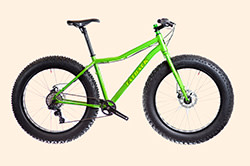
Reinventing the wheel: life cycle
The origins of fatbikes are somewhat murky. Most people agree that two men, one in Alaska and one in the American southwest, each came up with early versions of fatbike wheels by welding together two mountain bike rims. One version, the SnowCat, designed by Simon Rakower in the late 1980s, was intended for riding on snow. The other, designed by Ray Molina at about the same time, was meant for riding across deserts.
In 2005 Surly, a bike company based in Minnesota, offered the first large-scale production fatbike, the Pugsley. Since then, fatbikes have gone mainstream with many big bike manufacturers and scores of smaller ones offering them. OnOne, Salsa, Trek, Specialized and Kona are just a few attempting to cash in on the trend and for good reason: annual sales of fatbikes in the US leapt to $7.1m in the year to March 2014, a 141 per cent rise on the previous 12 months, while sales in the first quarter of this year topped $3.8m, according to research company NPD.
Comments